January 8th, 2014
| 2 Comments »
We’re on the upswing of some pretty intensely cold weather. Thankfully it was brief, only a few days, but the deep freeze shut down the state in ways that I haven’t seen in almost 20 years.
I’m old enough to well recall the last two deep freeze spells that came through Minnesota; the last one, in 1996 caught me inside a superbly drafty, old house and my poor baby, barely even 2 years old, was wrapped up so tight in layers that he could barely toddle around. We spent a lot of time snuggled in blankets watching PBS and reading books. And prior to that, in 1994, I was carrying him around on my insides, and so toasty warm with extra weight and hormones that I walked to the bus stop in -20 temperatures, with a cruel wind to boot, in an open winter coat that flapped in that vicious breeze. And I was still too warm. I didn’t get any frostbite, but I sure got some weird looks.
And here’s the thing; yes, by golly, it’s cold. But that just means more layers, more awareness when going out. I was outside on both of our recent cold days and although I could certainly vouch for the bone-chilling wind, I was dressed properly and felt just fine. Not fine enough for being out very long, taking a walk or getting out the nordic skis, but there was no fear in running errands and going about my business. Working in a grocery store led me to witness some pretty bizarre behaviors in people buying up supplies like an apocalypse was upon us, but quite frankly, I’m more fearful of being out in a blizzard than I am of dealing with a polar vortex. Cold is not so bad if you aren’t afraid of it.
We did have a big hiccup with Mike’s car, though, as he willingly allowed Griffin to park his car in our garage overnight so that when he had to leave for work at 4:30am, his car might start a bit easier. Which it did. But, as you can imagine, Mike’s car wouldn’t start after being out overnight in -50 wind chills. After multiple attempts to get the engine running, he disconnected the battery and brought it inside to warm up, keeping it connected to an electric charger. The next morning, the car roared to life as it should. Bottom line: if your car has to be outside, try taking the battery inside on those brutal nights. It’s a little extra work that might save you from a dead vehicle. And an electric charger should be in everyone’s arsenal.
Our fireplace got a lot of use over the past week, too. It’s gas, which isn’t our favorite, but you can’t beat it for ease and for incredible warmth. The fireplace has a blower that sends the warm, heated air out in to the room, and I curl up on the sofa in front of it, cats draped across my lap, my knitting in hand and a movie or TV show on Netflix and can pretty much forget that’s it’s not a fit night for anyone outside our windows.
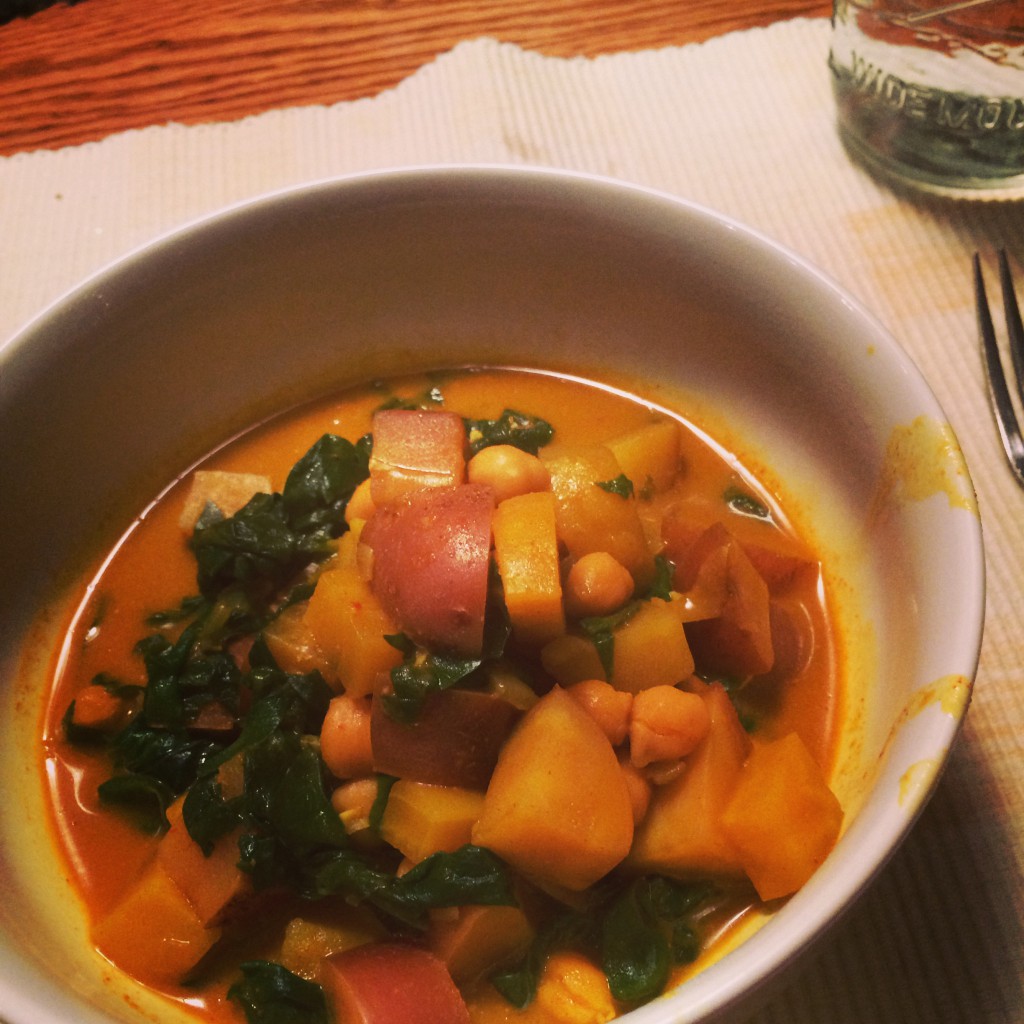
At the top of every coping mechanism, however, is the food we love to consume when the weather bottoms out. You all know that I love soup, almost beyond words, and for one of our bitterly cold night, I made a simple pot of simmered beet greens, chickpeas and red-skinned potatoes from our Fall Storage CSA share. Simmered in turmeric-laced coconut milk, spiked with red curry paste, it was enough to cut through even the most bone-rattling cold, warming us right to our toes. Beet greens {and all hearty greens, like kale, mustard greens, collard greens, and chard) become silky smooth, nearly melting in your mouth when simmered slowly, and this method has made me a huge fan of just about any dark, leafy green, loaded with the iron our bodies need. This soup is pretty similar to my popular Braised Kale & Chickpeas recipe, with a few tweaks here and there. The addition of turmeric adds lovely color, and the wonderful anti-inflammatory properties that turmeric offers.
We’re expected to warm up in to the low 30’s by the weekend, and I can’t even imagine how delightful that’s going to feel after this last blast of arctic air, but, sadly, weather patterns hint at the brutal cold returning all too soon. There’s lots of Winter left. Plenty of soup to be made, I imagine.
Greens, Potatoes & Chickpeas in Coconut Milk
1 large bunch dark, leafy greens such as Beet, Collard, Chard or Kale, washed, de-stemmed & rough chopped
1/2# red-skinned potatoes, scrubbed and cut to 1/2″ {leave the peels on}
2 c. cooked chickpeas {equal to 1 15-oz can, rinsed well}
1 15-oz can coconut milk {use full fat for best flavor}
1 c. water
2 T. ground turmeric
2 T. red curry paste {optional, but you’ll love how it warms you from the inside}
1 large shallot, minced
3 cloves garlic, minced {use less, or more, to taste}
In a deep skillet, warm oil of choice and sauté the shallot and garlic with a big pinch of salt until softened, about 5 minutes.
Add in the greens by the handful, stirring to help them wilt slightly. When all the greens are added, pour in the coconut milk and water, and stir to combine. You won’t have a ton of broth, and you don’t need a lot. Add the curry paste and whisk to incorporate, then sprinkle the turmeric over everything and stir until combined. Bring to a simmer, add the potatoes and chickpeas, then cover and cook over low heat until the potatoes are just fork tender, stirring occasionally. Don’t cook them to the point of falling apart. The greens should be silky smooth.
Season to your taste with salt and pepper, then ladle in to bowls.
January 31st, 2012
| 4 Comments »
Previously in this space, we talked about mushrooms. Specifically, we talked about my quick and decisive learning curve that led me to an all-out lustrous affair with fungus.
Today, it’s all about Beets.
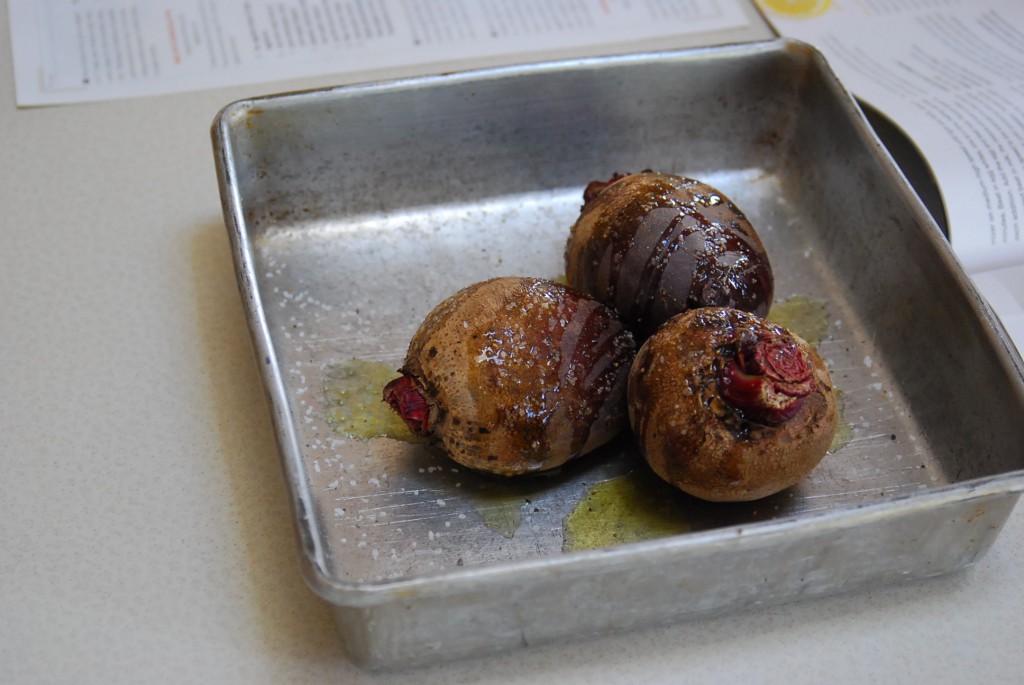
Beets and I had a torrid love affair back in 2009; it was then that I discovered the merits of this earthy root vegetable, one that turns tender and appealing from a long stretch in a hot oven; that it’s earthiness and deep, dark flavor isn’t so overpowering when paired with any number of other ingredients, and most specifically, that the nutrients in this little orb are well worth an incorporation to one’s regular eating. The greens also made their way in to my heart, one of the first to do so, and I believe they were responsible for me learning to love all things dark green and leafy.
Beets have a spectacular nutrient profile, primarily being a superb source of anti-oxidants, with anti-inflammatory and detoxification properties as well. Beets are in the same Chenopod family as spinach, chard and, surprisingly, quinoa. And while they contain an incredible amount of anti-oxidants, it’s the specific ones in beets- lutein and zeaxanthin- that make these vegetables stand out with their nutritional defense for your well-being. Lutein is especially beneficial for eye health, and the anti-oxidant mix in Beets is highly supportive of the nervous system. The anti-inflammatory properties of Beets also support heart health, and can help balance inflammation brought on by Type-2 Diabetes.
But even with all that, many people can’t get past the taste of Beets. They are dark and earthy, and quite honestly, I struggled with them at first, but I discovered that the lovely gold Beets are far less heavy tasting than their red cousins. Once I was able to enjoy the gold, I tried several recipes with the red and found a lot to enjoy about them as well.
Then, along came this recipe, pairing mellow and tender roasted beets with garlic studded mashed potato in a classic Skordalia. One bite and I was in love. With Beets. Again. Oh the glory…..
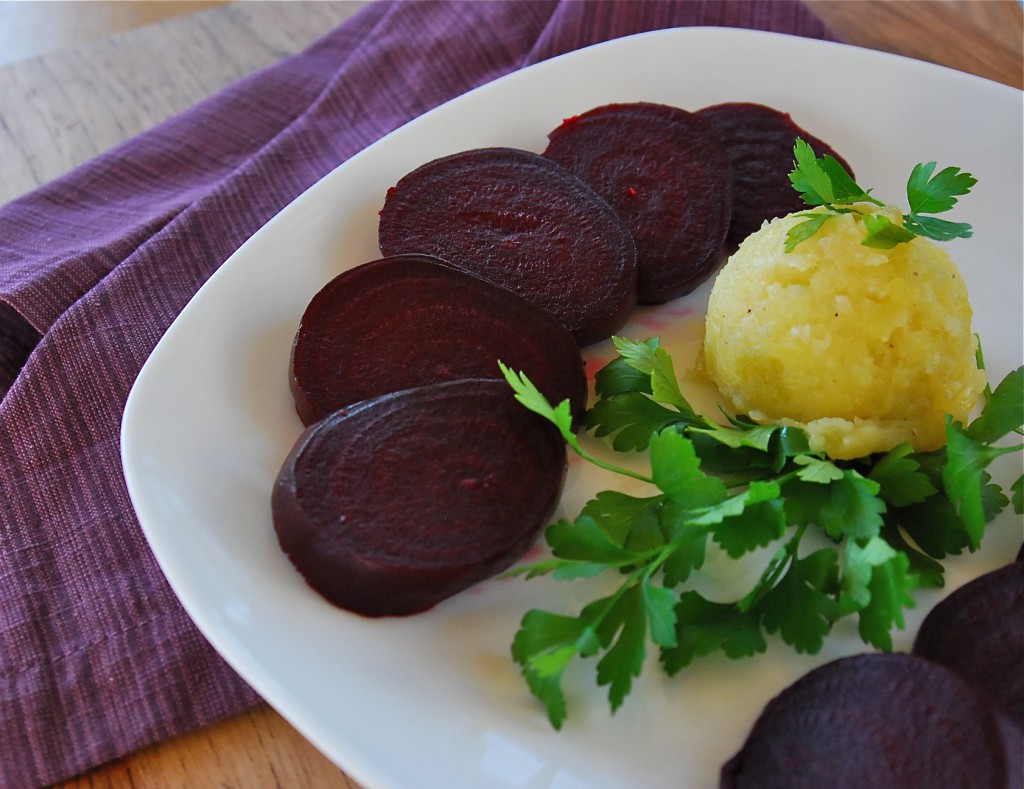
Served warm, with toasted pita bread on the side, this simple, non-fussy dish was rich with flavor and texture. The soft, fragrant potato mix, studded with garlic and thickened with a swirl of a soft, fruited olive oil lends a beautiful contrast to the hearty and tender roasted beets. I would have never imagined that the two of these foods together, both so simple and humble, would be so perfect.
Roasted Beets with Skordalia
4 medium red beets (about 1 1/2 lbs.) trimmed and cleaned
10 tbsp. extra-virgin olive oil
Kosher salt and freshly ground black pepper, to taste
1⁄4 cup finely ground toasted walnuts
1 tbsp. red wine vinegar
6 cloves garlic, smashed and minced into a paste (I sauteed the garlic in some of the olive oil before adding it to the potato for a more mellow garlic flavor)
2 medium russet potatoes,
peeled and cut into 1″ squares and boiled until tender
Heat oven to 425°. Put beets in an 8″ x 8″ baking dish and drizzle with 2 tbsp. oil. Season with salt and pepper and pour in 1 cup water. Cover pan tightly with foil and crimp edges to form a seal. Bake beets until a knife inserted into beet slides easily into the center, about 1 hour. Transfer pan to a rack, carefully uncover, and let cool for 30 minutes. Peel beets and cut into 1″–2″ pieces; set aside.
Put walnuts, vinegar, garlic, and potatoes into a medium bowl and mash potatoes until smooth. Vigorously stir in remaining oil and season with salt and pepper. Transfer beets to plates and serve with some of the skordalia spread on the side.
Recipe posted in it’s entirety from the original source in Saveur magazine, issue #131.
September 7th, 2009
| 3 Comments »
I’m not sure why, but I’ve been rather shy about mint in my cooking career. Did I have a traumatic experience with mint at some point in my life? The overdose on wintergreen Life Savers that I went through as a child? Why has mint not been forefront in my culinary dishes?
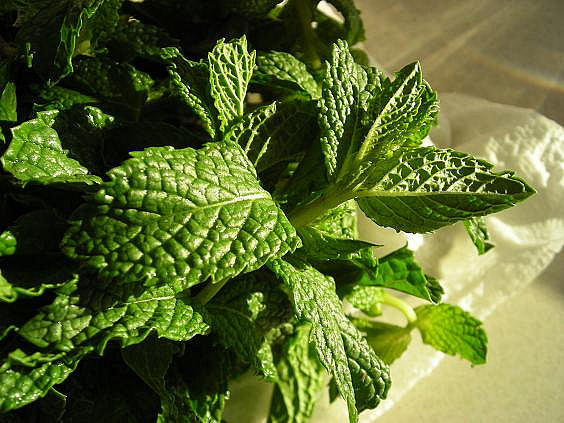
I haven’t an answer, but as of late, I seem to be making up for lost time on the mint appreciation. It’s been all over the place.
I love it muddled in a glass with chilled green tea poured over it. I’ve shredded it into salads and sprinkled it in pilafs. I ate some over sweet melon chunks, sighing in contentment at the contrast in flavors. It’s wonderful mixed with fresh oregano in any corn dish (hint: leftover cooked fresh corn, cut from it’s cobs needs nothing more than fresh oregano, fresh mint, a drizzle of olive oil and some salt and pepper. Toss it on a salad. You’re welcome)
Mint has been a regular in my fridge as of late and I’m only just beginning to understand the reaches to which this herb can go. A huge thick bunch is about $1.50 at the grocer, and wrapped in a damp paper towel in a plastic bag, it lasts for quite some time in my fridge. The last thing I ever thought I would be doing would be eagerly and gleefully searching out recipes that will include mint. Or making them up, as it turned out. Like this Lemon Mint Potato Salad with Green Beans.

I browse hundreds of food sites, recipe sites and food information in any given week. I am always undertaking a study of food in all it’s glory from the amazing array of food blogs both stellar and odd, to the sites that talk food, culture, nutrition and diet. I know that somewhere in my browsing I came across a dish similar to this because it’s the only way I can think that it got into my brain at some point, and the mere action of holding onto a bunch of mint at the grocer made it jump front and center, to the spot where all my creativity pours out. It’s rare that I really smack a home-run the very first time creating a recipe from scratch, but this one worked. On all levels. The crunchy beans, moist potato and superbly tart and lemony dressing, with hints of mint and dijon mustard come together in a lovely symphony of simplistic eating. I was sad when I was full.

Lemon Mint Potato Salad with Green Beans
by Kate
1# ‘B’ Red potatoes, quartered and steamed to tenderness
1/2# fresh green beans, blanched and shocked to cool
1/2 c. fresh mint leaves, washed and dried
Juice of half a lemon
2 t. lemon zest
1/4 c. olive oil
1 T. dijon (or other brown, deli style) mustard
1 oz fresh goat cheese, crumbled
Salt and pepper
Place potato and beans in a medium bowl. In a small measuring cup, whisk together lemon juice, lemon zest, olive oil, mustard, goat cheese and 2 T. of the mint until smooth and creamy. Season to taste with salt and pepper. It will be very tart and lemony, with a subtle mustard zing. Pour over potato mix and gently stir to coat. Serve room temperature or chill for an hour or more before serving. Top with mint leaves and extra salt and pepper before serving.
SIDE NOTE:
The kind folks at Ile De France cheese regularly send me free cheese to try at home, and I am very grateful for their generosity. The goat cheese used in this recipe is one of their offerings, a 10.5 oz chunk that is fresh and flavorful, with a subtle hint of herb and grass and a terrific texture that crumbles easily, melts superbly and whisks smooth in any number of options. It lasts for a good long time wrapped up properly. Thanks so much Ile De France!!

June 15th, 2009
| 9 Comments »
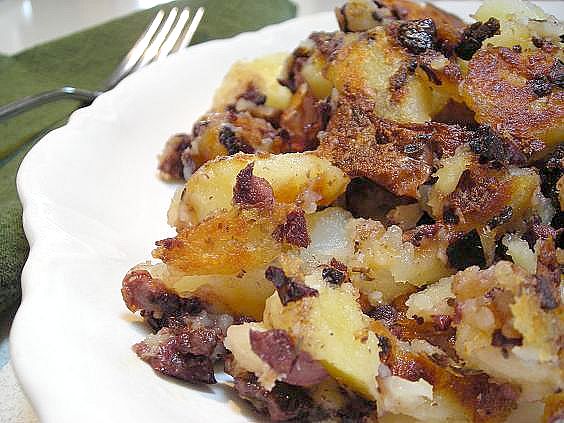
From my lips to yours, I never would have thought to put these two flavors together in all the world of combination’s; one so briny, the other so mellow- who would have thought that they’d be any good together?
Thankfully someone did, and they had the fortitude to put it in a cookbook for all of us to see. And for me to find. I love a good potato, especially charred in a hot pan, a nice crust on the outside. And tapenade? I have no reticence, and no restraint for all things constructed of chopped olives. I’ve been known to use a pastry brush to glean the remains from any given jar that crosses my doorway. I love the stuff that much.
The ironic thing was, several days before I happily discovered this recipe in the New York Times Dining Section, I was browsing through the cookbook ‘Seven Fires: Grilling the Argentine Way’, from where this recipe came, by Francis Mallman and Peter Kaminsky. I was enraptured, and getting hungry. I even saw this recipe and thought to myself, once again, about whether or not it was wise to purchase a cookbook based on one divine recipe in it, decided that yet again I couldn’t justify it, and placed it back on the shelf. Then my normal Wednesday browsing on the NYT site nearly made me shout out loud.
What was unexpected was that I had all the ingredients right in the pantry to make it .
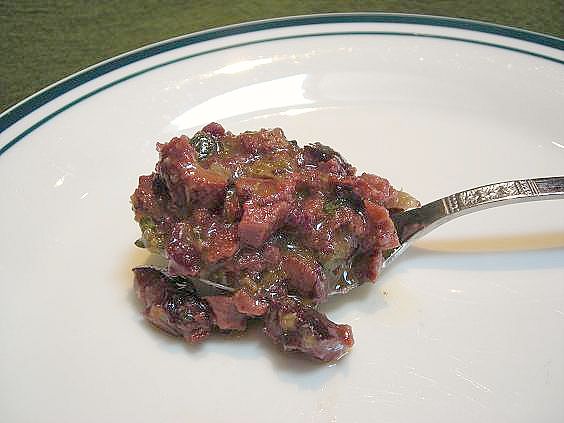
What wasn’t so expected? I waited, for more than a week, to actually do it. Had I known, or better yet believed fully that I would love this to the extent that I did, I would not have hesitated one instant to put it together, and I encourage you to do the same. For breakfast. For brunch. For a nice supper, a late night snack.
But hesitate I did, and the tapenade, thrown together in about 10 minutes, languished in the fridge in it’s oil and vinegar bath, most likely improving in flavor immensely prior to me unearthing it. And the finished product was so outstanding and perfect that I awoke the next day craving more.
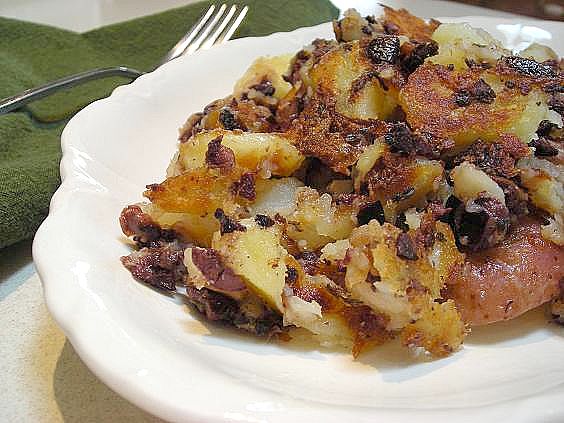
When I think of Smashed Potatoes, I think of a fluffy mash of skin-ons. This is more like Home Fries, Fried Potatoes or anything of the same sort, and the crusty-ness of the potato chunks is one of the biggest pulls of this dish. The pairing of the briny and sharp tapenade with the mellow, mild potato seems unlikely; too much of one and not enough of the other, but the mix is divine, the flavors perfect in their execution.
Smashed Potatoes with Tapenade
Adapted from ‘Seven Fires: Grilling the Argentine Way’ by Francis Mallman and Peter Kaminsky (via the New York Times Dining Section, 5/20/09)
For the Tapenade:
1 c. kalamata olives, minced
2 T. capers, minced
1 t. grated lemon zest
1 T. fresh lemon juice
1 1/2 t. fresh thyme, chopped
1/2 c. extra virgin olive oil
Fresh ground black pepper
Mix everything in a bowl. I stirred in about a tablespoon of red wine vinegar and it sat in my fridge for at least a week.
For the Potatoes:
About 1-1/2 pounds of waxy small red or white potatoes,
2 T. red wine vinegar
1 bay leaf
6 black peppercorns
Salt
Wash potatoes. If not uniform in size, cut to size and boil, with all added seasonings, until tender. Drain and discard seasonings. Gently break the potatoes into smaller chunks. I did this on a paper towel.
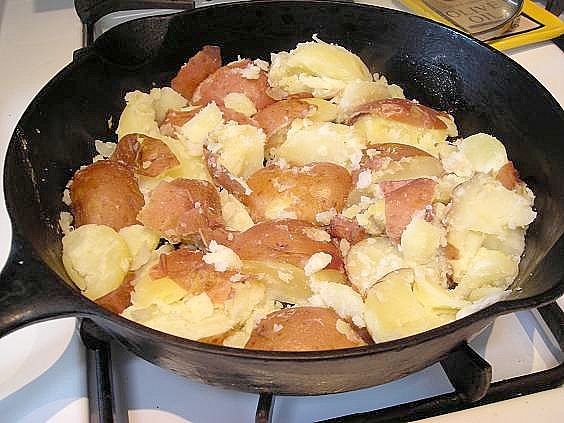
Heat a heavy seasoned skillet until very hot (a drop of water immediately sizzles and evaporates). Place potatoes in skillet and cook without stirring for about 10 minutes. Dot top with tapenade and gently turn potatoes over. Cook on other side for about 10 minutes more, or until crisp and browned. Serve immediately.
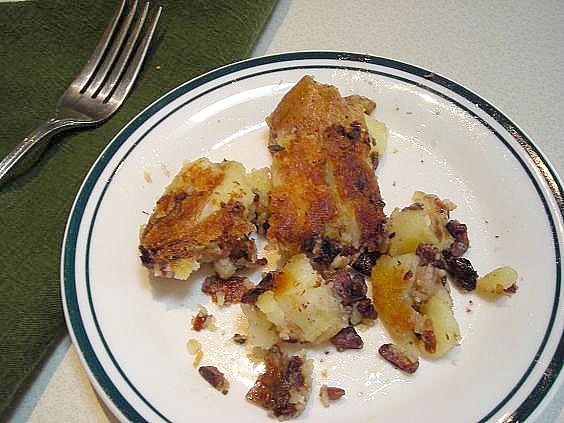
An excellent option:
Cook the potatoes and tapenade until hot and crispy. Push aside from the center of the pan, making a circle and drop two eggs onto the hot pan. Cook to desired soft or hard stage and serve with potatoes.
A warning:
Although these flavors are wonderful together, it could easily be overpowering by adding too much tapenade. The recipe given makes a nice amount, but I caution against using all of it with the potatoes, as the original recipe seems to suggest. Add in less than you might think, and taste when it’s hot. There should be a nice balance between the two flavor components. If you wish for a sharper taste, add more of the tapenade.
And a great suggestion:
Use some of the oil from the tapenade to flavor the potatoes as they cook. The recipe calls for a half cup olive oil for the tapenade and it seems like a lot until you realize how flavorful it gets, and how it can really amp up the end result of this dish. Use it, and love it.
|











